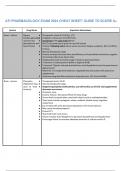lOMoARcPSD|298 28
ATI PHARMACOLOGY EXAM 2024 CHEAT SHEET/ GUIDE TO SCORE A+
System Drug Name Important Information
Heart - Failure Digoxin ● Therapeutic Levels 0.5-0.8 (Pg. 177)
(cardiac glycoside●, IV digoxin: infuse over AT LEAST 5min.
used to treat ● WITHHOLD if HR LESS THAN 60/min
dysrhythmias and MUST auscultate apical pulse for one full minute
heart failure) ● Toxicity: Yellowing vision, blurry vision, anorexia, fatigue, weakness, N/V, GI effects,
tinnitus,
● Narrow therapeutic range
● Positive inotrope (Increase force and efficiency of myocardial contraction), negative
chronotrope (Decrease Heart rate)
● Hypokalemia leads to toxicity, hyper K leads to decreased effect
● Treatment is cholestyramine (BAR) or Digibind (FAB)
● To prevent “Digoxin-induced dysrhythmias, avoid hypokalemia and increased serum
digoxin levels
Watch for n/v and general weakness. (hypokalemic) and caution with potassium
supplements.
● Avoid any drug that affect potassium (loop diuretics, ACE Inh and ARBs)
Brain - seizure Phenytoin ● Therapeutic levels 10-20
(hydantoin class, ● Narrow therapeutic range
used to treat ● Gingival hyperplasia (notify dentist, use soft brush); use of folic acid supplements
seizures) decreases occurrence
● Hirsutism, acne
● Enzyme inducer- decreases effects of many drugs
● Serum level increased when used with valproic acid or methylphenidate
● Toxic levels include nystagmus, ataxia, sedation, double vision, cognitive
impairment
● Do not take with milk, decreases absorption of Vit D and Calcium
● May cause thrombocytopenia
● Check LFT’s
● Stop med if skin rash occurs
● Infuse no faster than 50mg/min to decrease dysrhythmias and hypotension
● Encourage clients to consume adequate amounts of calcium and vit D
,Brain - seizure Carbamazepine ● Therapeutic levels: 4-12
● Hepatic Autoinducer- oral contraceptives and warfarin
● Blood dyscrasias (leukopenia, anemia, thrombocytopenia, bone marrow
suppression) /pancytopenia
● Stimulates posterior pituitary and promotes secretion of ADH so hypo-osmolarity -
essentially a medication induced SIADH
● Can cause SJS (treat minor reactions with antihistamine, wear sunscreen, and notify
provider)
● GI distress, drowsiness, rash, nystagmus, double vision, vertigo, staggering
● gait, and headache
● Start with low dose and titrate up
1
, ● Administer at bedtime
● Obtain baseline CBC and platelets, and perform ongoing monitoring
● Observe for indications of bruising and bleeding of gums
● Monitor for sore throat, fatigue, or other indications of infection
● Hepatotoxicity- Evidenced by anorexia, nausea, vomiting, fatigue abdominal pain,
and jaundice
Brain - seizure Valproic Acid ● Monitor liver and pancreatic enzymes due to damage
● Can be used in any type of seizure
● Hepatotoxicity- anorexia, nausea, vomiting, jaundice, abdominal pain, fatigue
● Pancreatitis- nausea, vomiting, abdominal pain
● Thrombocytopenia- bruising; monitor platelet count
● Teratogenic
● Enzyme inhibitor
● N/V, indigestion- take with food
● Weight gain
Chemo Methotrexate ● Used in chemotherapy, psoriasis, rheumatoid arthritis
● Interrupts cell production, so monitor for bleeds in GI/mucosa/gums. Use soft
brushes. Protect skin.
● Pregnancy Cat X (stops cell production) and is used to dissolve pregnancy. Moms
need to be on strict birth control.
● Don’t give with folic acid
● Give with leucovorin (prevents side effects)
● Due to immunosuppression, report fever to provider stat
● Dosed weekly
● Sores in mouth (stomatitis) indicates toxicity.
Diuretic Mannitol ● Adverse effects: Peripheral edema, Pulmonary edema (can potentiate HF)
(Osmotic diuretic●
) ↓ intracranial and intraocular pressure - used in glaucoma
● Lung crackles should be recognized as an indicator of potential complications
GI Sucralfate ● Protects mucosa (ulcers)
(Mucosal ● Causes constipation, so teach patients to increase fiber and fluid
Protectant)
Pain Morphine Sulfate● Primary use is analgesia
● Teach patients about side effects:
Respiratory Depression
Constipation
Orthostatic Hypotension
Urinary Retention
Can cause biliary colic
Diuretic Acetazolamide ● Diuretic - carbonic anhydrase
(Carbonic ● Used to decrease IOP in glaucoma patients
Anhydrase ● Adverse effects include paresthesias (tingling of the extremities), hyperglycemia
Inhibitor)
2




